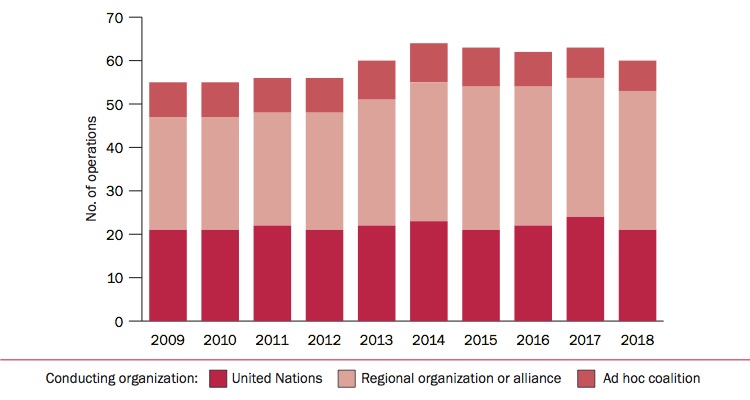3. Peace operations and conflict management
The North Atlantic Treaty Organization (NATO) Mission in Iraq (NMI) was the only new multilateral peace operation established in 2018 and only two closed—the UN Mission in Liberia (UNMIL) and the Southern African Development Community (SADC) Preventive Mission in the Kingdom of Lesotho (SAPMIL). There were 60 multilateral peace operations active in 2018, the lowest number since 2013.
The number of personnel serving in multilateral peace operations decreased for the third year in a row. It was 144 791 by the end of 2018: 95 488 in UN peace operations (a reduction of 2.9 per cent in 2018); and 49 303 in non-UN multilateral peace operations led by regional organizations and alliances or by ad hoc coalitions of states (an increase of 3.7 per cent in 2018). NATO accounted for most of the latter increase by reinforcing the Resolute Support Mission (RSM) in Afghanistan. The total number of personnel deployed in Africa fell for the third consecutive year, to the lowest level in five years: 104 238 personnel.
Trends in United Nations Peace Operations
Around 66 per cent of all personnel in peace operations are deployed in UN peace operations and some 72 per cent are in Africa. Nonetheless, a trend appears to be developing away from the UN and away from Africa. This is primarily because of the continuing negative atmosphere surrounding UN peace operations, especially over budgets and fatalities, as well as an increasing belief in militarized solutions.
The UN peacekeeping budget decreased from $7.9 billion in 2016–17 to $6.7 billion in 2018–19, mainly as a result of the closure of missions already scheduled to drawdown, rather than new approaches or increased efficiency. If no new missions are established, further reductions can be foreseen following the closure of the African Union/UN Hybrid Operation in Darfur (UNAMID) and the UN Stabilization Mission in the Democratic Republic of the Congo (MONUSCO). In addition, many of the cuts sought by the administration of US President Donald J. Trump have not yet taken place.
In 2018 the number of fatalities in UN peace operations linked to malicious acts decreased sharply in comparison to 2017. The 27 hostile deaths were less than half the number in 2017 and the lowest since 2012. However, 2017 was an extreme year and the number of personnel deployed has also declined. In 2018 the number of hostile deaths per 1000 deployed uniformed personnel was back to 2013–16 levels. Moreover, while conditions in the UN Multidimensional Integrated Stabilization Mission in Mali (MINUSMA) improved, the number of deaths remained relatively high in the UN Multidimensional Integrated Stabilization Mission in the Central African Republic (MINUSCA) and MONUSCO.
Militarized solutions
The Trump administration is only partly responsible for the increased emphasis on militarized solutions. It is also illustrated by earlier European Union and NATO training and mentoring missions (e.g. the NMI and the RSM, which sought to enable local forces) and regional coalition-based multilateral non-peace operations (e.g. the Joint Force of the Group of Five for the Sahel, JF G5S, and the Multinational Joint Task Force, MNJTF, against Boko Haram). While UN peace operations clearly have their challenges, it remains to be seen whether the alternative of training national forces and setting up multilateral non-peace operations to fight insurgents and ‘terrorists’ will be more productive. In the Sahel, for example, further destabilization has occurred, the JF G5S and the MNJTF have come under sustained attack and national forces have been implicated in serious human rights abuses.
United Nations peacekeeping reforms
The UN is continuing its ‘peacekeeping reforms’. The UN secretariat is working to implement the recommendations of the Cruz Report on reducing hostile deaths, and has begun strategic reviews of operations focused on the prevention of and response to sexual exploitation and abuse. On 1 January 2019 it implemented a reform of the UN’s peace and security architecture. In the context of the Secretary-General’s Action for Peace (A4P), UN member states and other partners and stakeholders agreed a ‘Declaration of Shared Commitments’ in 2018 on topics such as the protection of civilians, safety and security, and performance and accountability.
While the UN secretariat is introducing reforms to keep UN peace operations relevant, the challenges associated with training and mentoring missions and multilateral non-peace operations remain significant. It is still too early to tell what will become of UN peace operations and whether other types of missions will become even more relevant for enhancing international peace and security.
